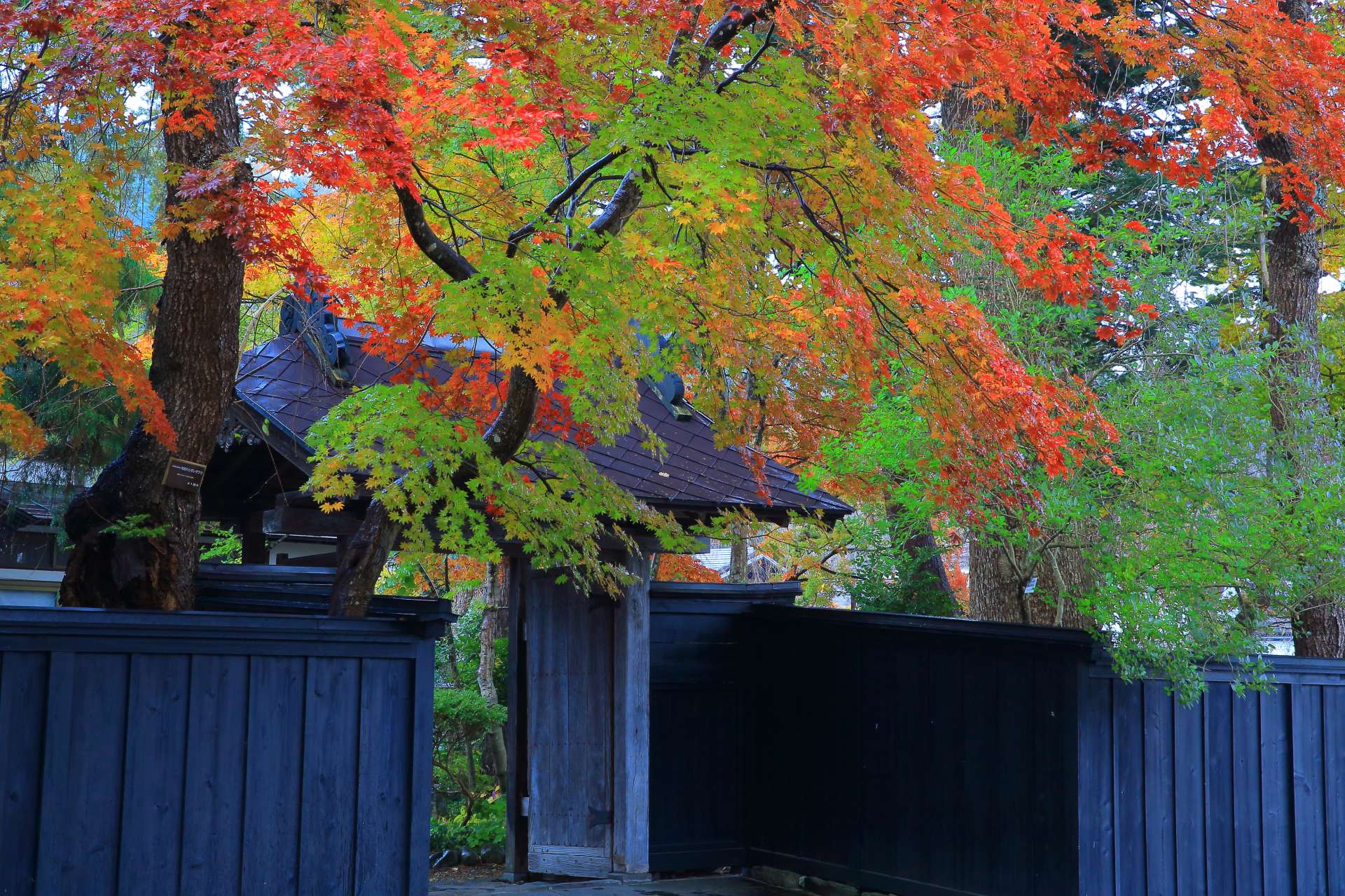
Fall Foliage Hikes in Kakunodate!
When it comes to the maple leaf, the red and black combination formed by the maple leaf and the black wall has an elegant as well as intoxicating beauty. This article introduces the itinerary of appreciating the architecture of the Pavilion and the beauty of maple red in Kakunodate.
Fall Foliage Hikes in Kakunodate
Located in Akita Prefecture’s Senboku, Kakunodate has a grid of neat streets, ancient samurai houses (bukeyashiki), temples and traditional simple warehouse, which makes this cozy town known as "Little Kyoto in the Northeast", a famous place for sakura-viewing and fall foliage.
Next, I would like to introduce a hiking trail for viewing fall foliage: set off from the neighborhood of Kakunodate Station, walk northward along the road of Bukeyashiki (Bukeyashiki-dori), to south along the road of Tamachi Bukeyashiki (Tamachi Bukeyashiki-dori), and return to Kakunodate Station.
- Kakunodate Tourist Association
- Tatetsu House (Rent Kimonos)
- Samurai House: Odano House
- Samurai House: Kawarada House
- Samurai House: Iwahashi House
- Samurai House: Aoyagi House
- Samurai House: Ishiguro House
- Kakunodate Birch Craft Densho-kan
- Samurai House: Matsumoto House
- Nishinomiya House
- Shinchosha Memorial Museum of Literature
- Ando Workshop
1. Kakunodate Tourist Association
It is a one-minute walk from JR Kakunodate Station to Kakunodate Tourist Association. Here you can get a free brochure introducing various sightseeing information, learn about the festivals and activities held at the time, etc. You can also buy local products on your return trip.
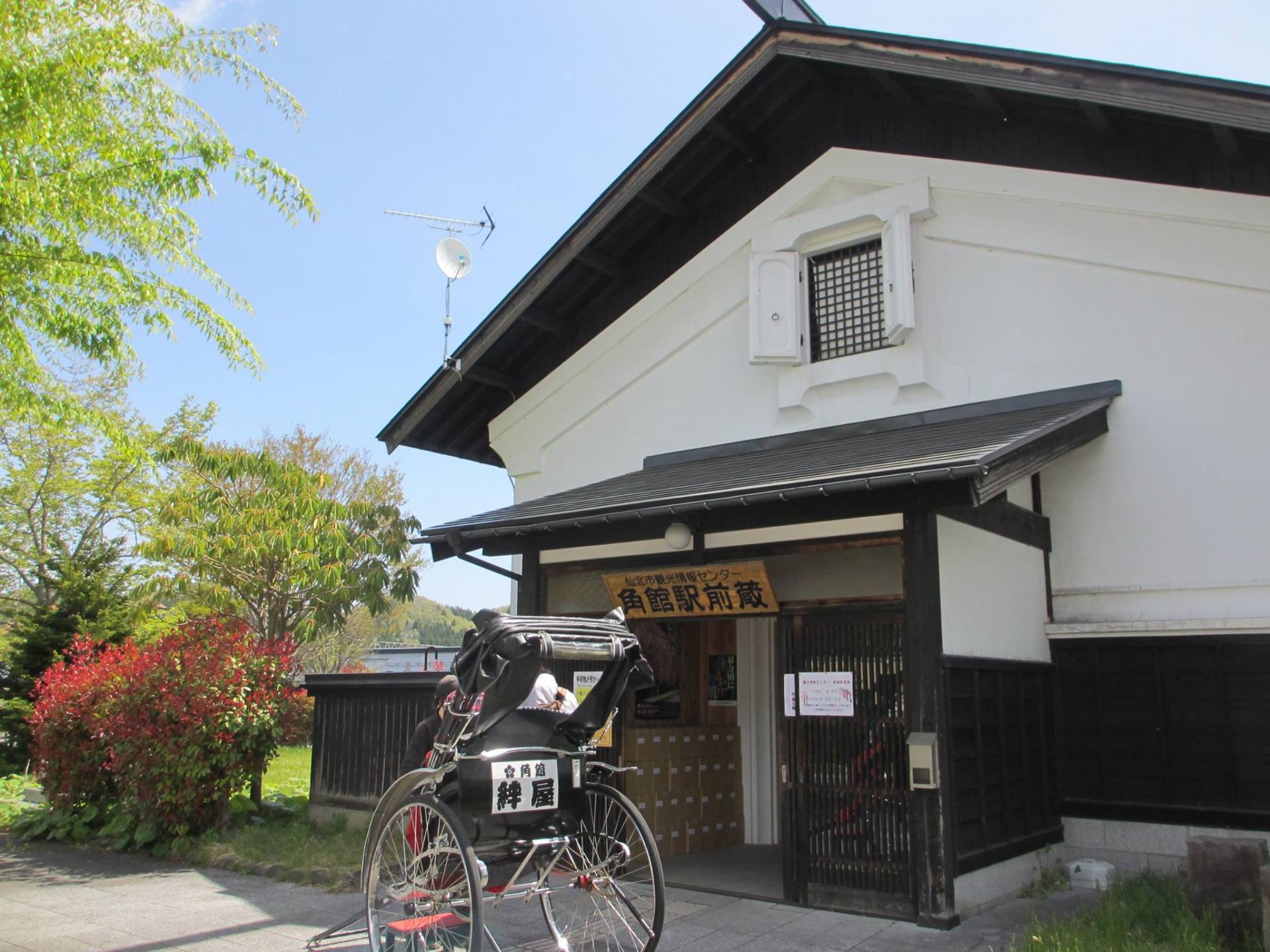
2. Tatetsu House (Kimonos Rentals)
There are many samurai houses of all sizes in the pavilion, all of which are residences of samurais and celebrities living between the 18th century and the 19th century. Dressing in Japanese kimono will certainly add a special flavor to your maple viewing experience!
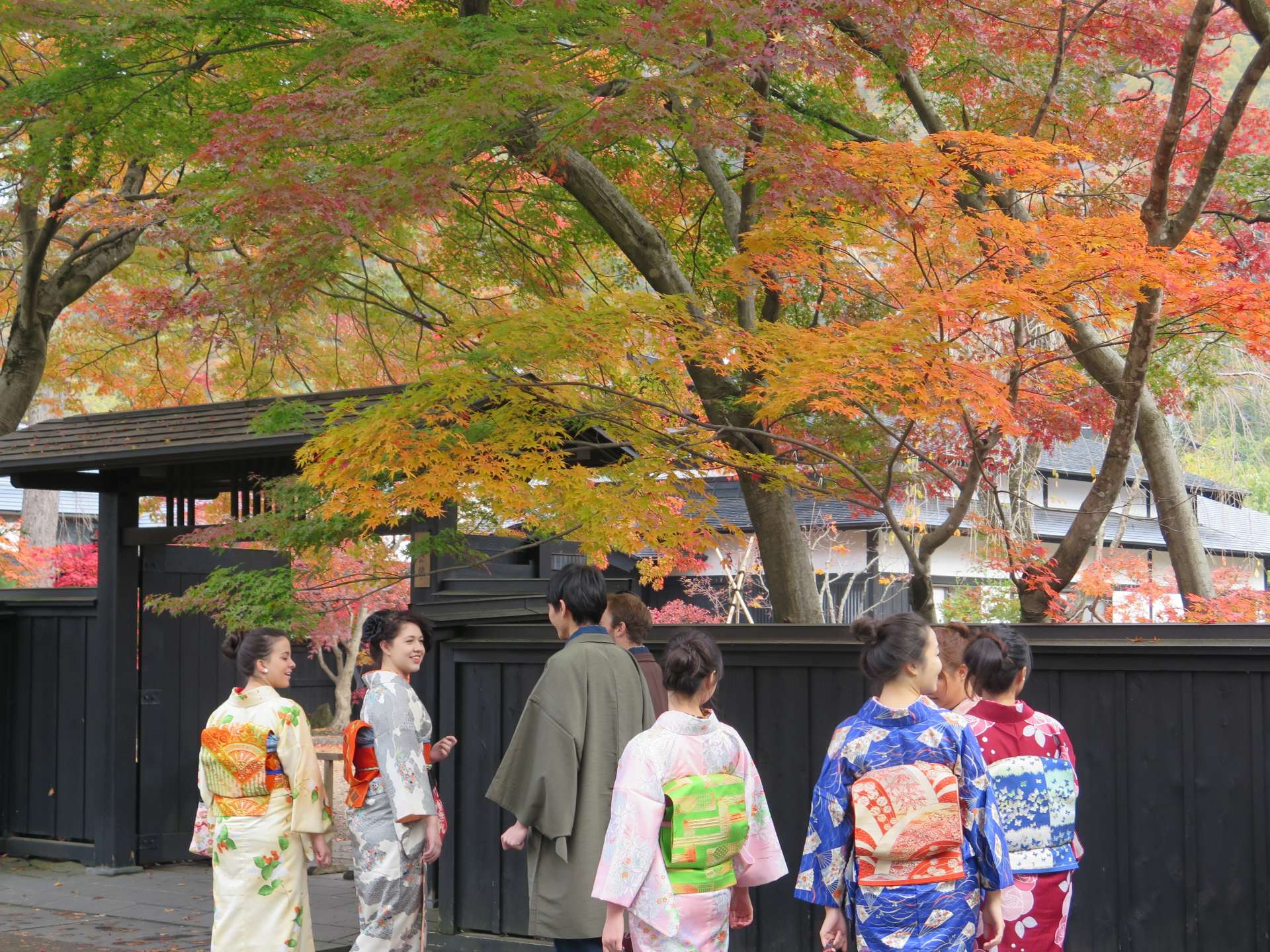
Kimono rentals are available from the Tatetsu House.
Basic Information on the Tatetsu House
- Address
- 25, Nakamachi, Kakunodate, Senboku, Akita Prefecture
- Appointment
- 0187-63-6751
- Hours
-
9:00-18:00
9:00-18:00 - Price
- 4,000 yen
- Time for rental
-
10:00-17:00
10:00-17:00 - Official website (in Japanese)
- http://www12.plala.or.jp/kabasen/event/index.html
When you walk northward along Bukeyashiki Street, you will be greeted with tightly packed beauties of black walls and fall leaves.

The bright red mailboxes and the black walls on the street make another combination of black and red.

3. Samurai House: Odano House
You will first visit Odano House, which is the simplest among all the famous samurai houses. Although the gable board (hafu) and the fish-shaped board (gegyo) decorating the roof were no longer there after the reconstruction following the fire in Meiji 33 (1900), the fall foliage looks enchanting.
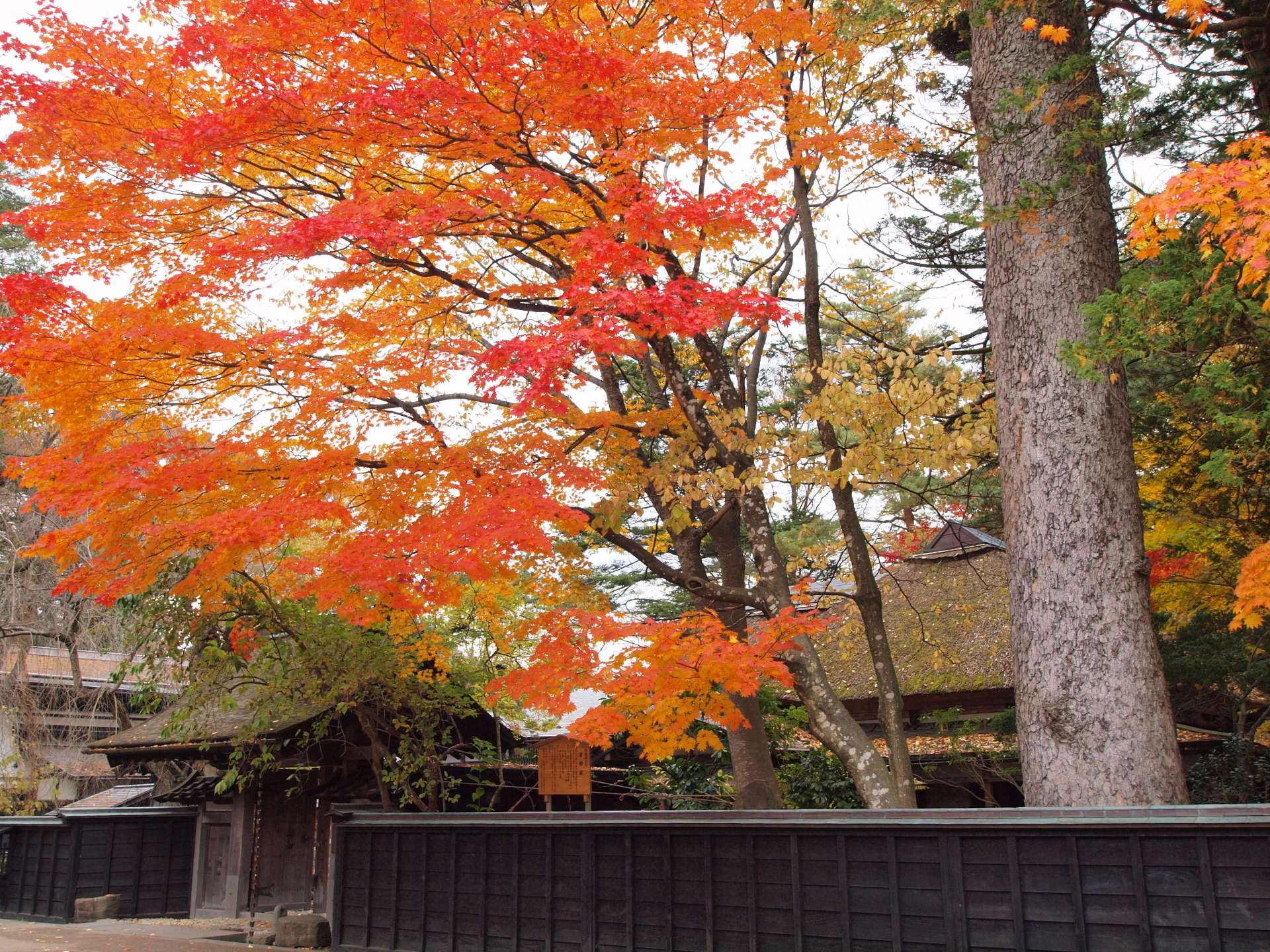
The scenery around the Odano House is characterized by giant maple trees, the tallest of which is up to 66ft. A master of Akita ranga painting was born in the house: Odano Naotake.
※Akita ranga also known as the Akita-ha, was a short-lived school of painting within the larger Japanese genre of ranga, or Dutch-style painting which lasted roughly from 1773 to 1780
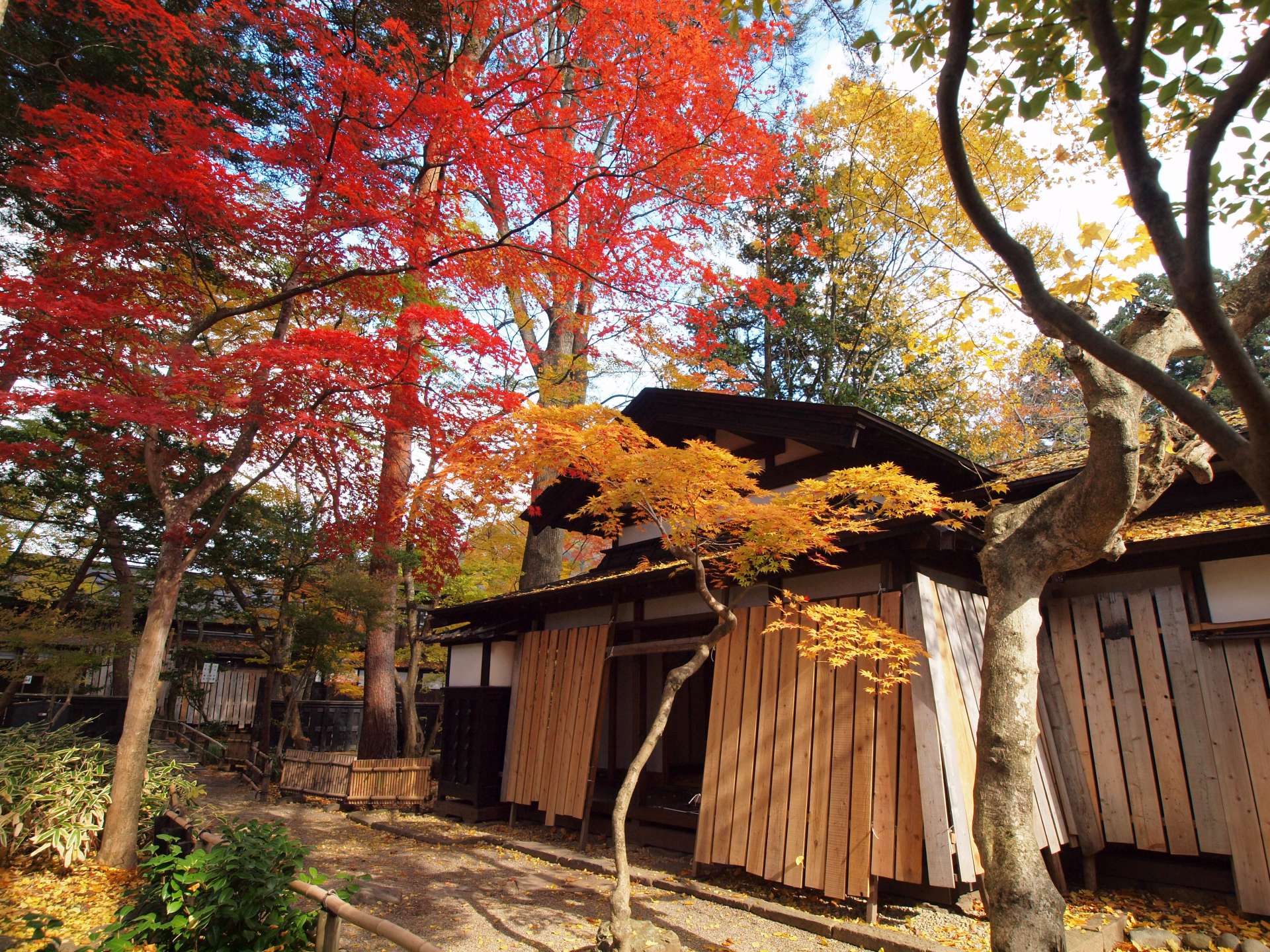
Basic Information on the Odano House
- Address
- 10, Higashikatsurakucho, Kakunodate, Senboku, Akita Prefecture
- Phone
- 0187-43-3384
- Dates
- Mid-April to November
- Hours
-
9:00-16:30
9:00-16:30 - Closed
- Winter
- Admission
- Free
4. Samurai House: Kawarada House
The Kawarada House was the family residence of Kawarada, who was a descendant of the Ashina clan, and moved from Fukushima’s Aizu to Kakunodate with the family of Ashina. The existing building was constructed during the mid Meiji period, and the architectural style of samurai (buke) houses in the Edo period remain the same until this day.
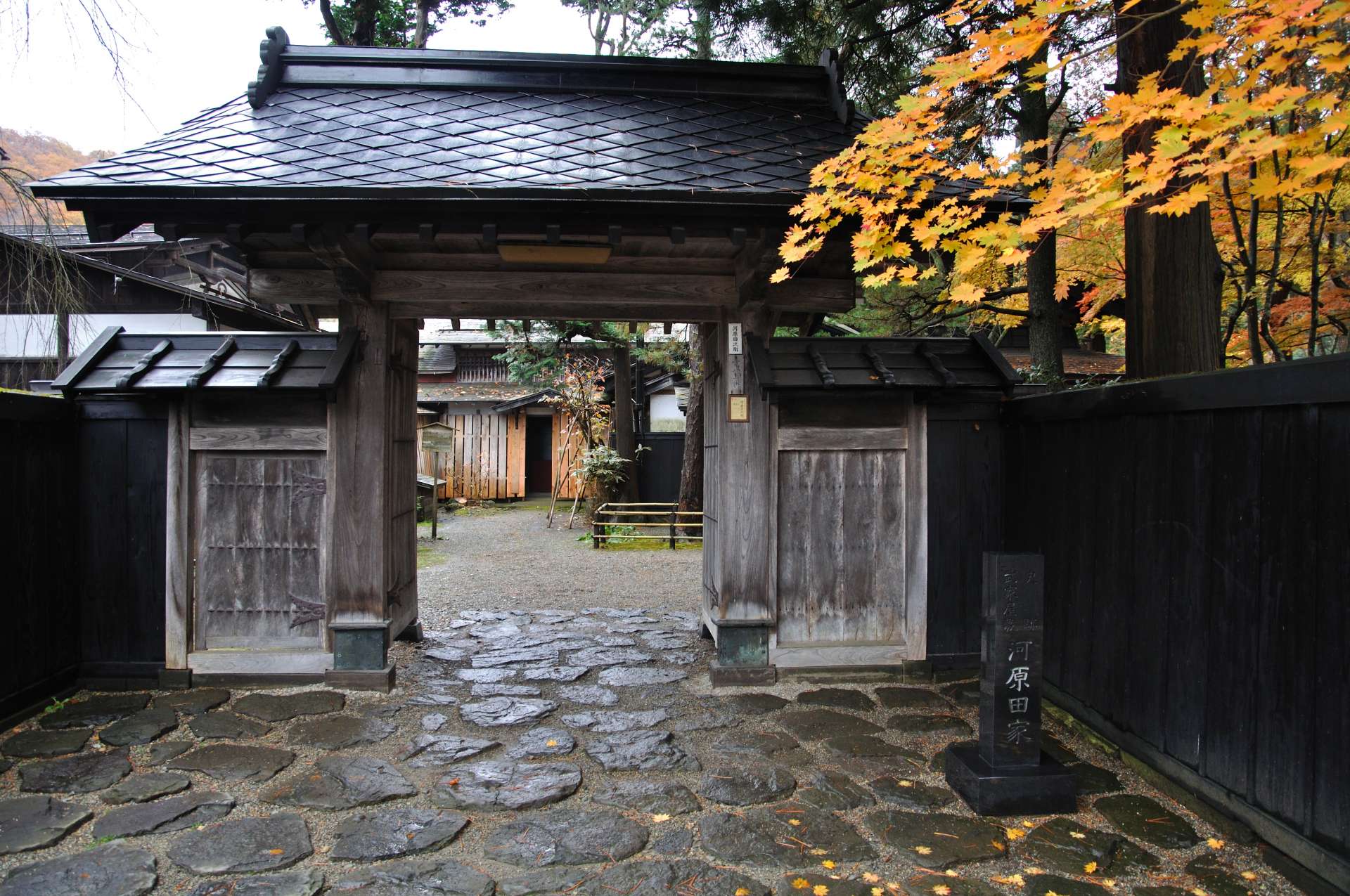
The Kaharada family is characterized by a secluded courtyard with fresh green in summer and maple red in autumn. Walking in the courtyard full of fallen leaves, you can not help but forget the noise of the outside world.

Basic Information on the Kawarada House
- Address
- 9, Higashikatsurakucho, Kakunodate, Senboku, Akita Prefecture
- Phone
- 0187-43-3384
- Dates
- Mid-April to November
- Hours
-
9:00-16:30
9:00-16:30 - Closed
- Winter
- Admission
- Free
5. Samurai House: Iwahashi House
The Iwahashi family also served the Ashina clan and occupied a rather wide area for being as "superior warrior" family. It was later used as the shooting place of the Japanese "period drama" (Jidaigeki) Film - The Twilight Samurai.
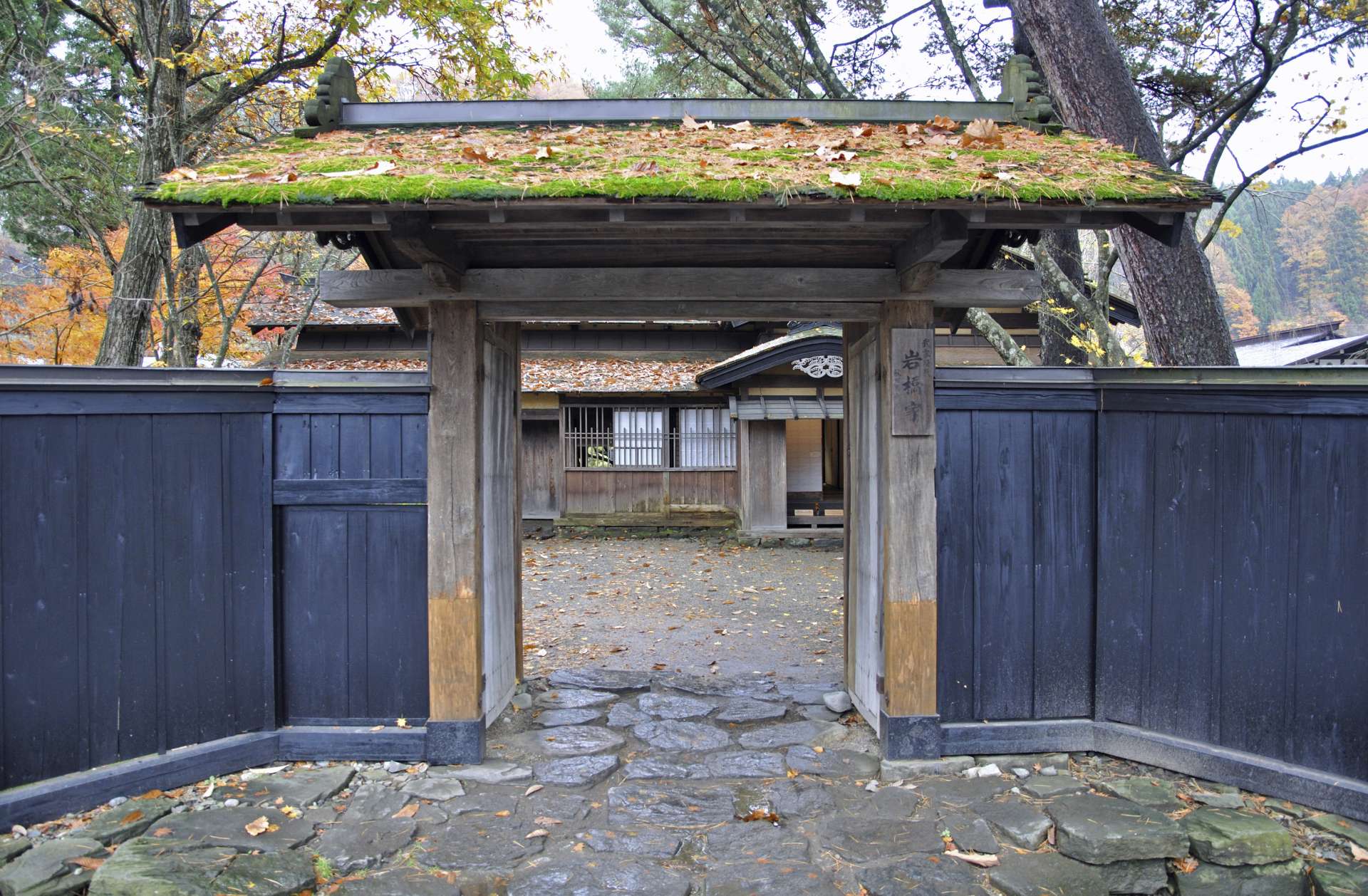
Kakunodate is dotted with so many wooden houses, so fire is especially dangerous. The huge fire that occurred in Meiji 33 (1900) destroyed such renowned residences as the above mentioned Odano House. But, the Iwahashi House survived the fire for its roofs made with shingles of shakes (thick wooden boards made of cedar) and its well in the courtyard.

With chestnuts, red pines, maples and oaks planted in the courtyard, the House is highly recommended among many samurai houses for viewing of fall foliage. It is said that an oak tree there is more than 250 years old, which is very rare in Akita Prefecture.

Basic Information on the Iwahashi House
- Address
- 3-1, Higashikatsurakucho, Kakunodate, Senboku, Akita Prefecture
- Phone
- 0187-43-3384
- Dates
- Mid-April to November
- Hours
-
9:00-16:30
9:00-16:30 - Closed
- Winter
- Admission
- Free
6. Samurai house: Aoyagi House
The Aoyagi household was once a vassal of the Satake clan, the most influential family at Kakunodate; After the efforts of generations of owners, and the Aoyagi Houseis now recognized as the most spacious and luxurious residence among the samurai houses in Kakunodate. Later, The Hidden Blade, a Jidaigeki movie was filmed here.
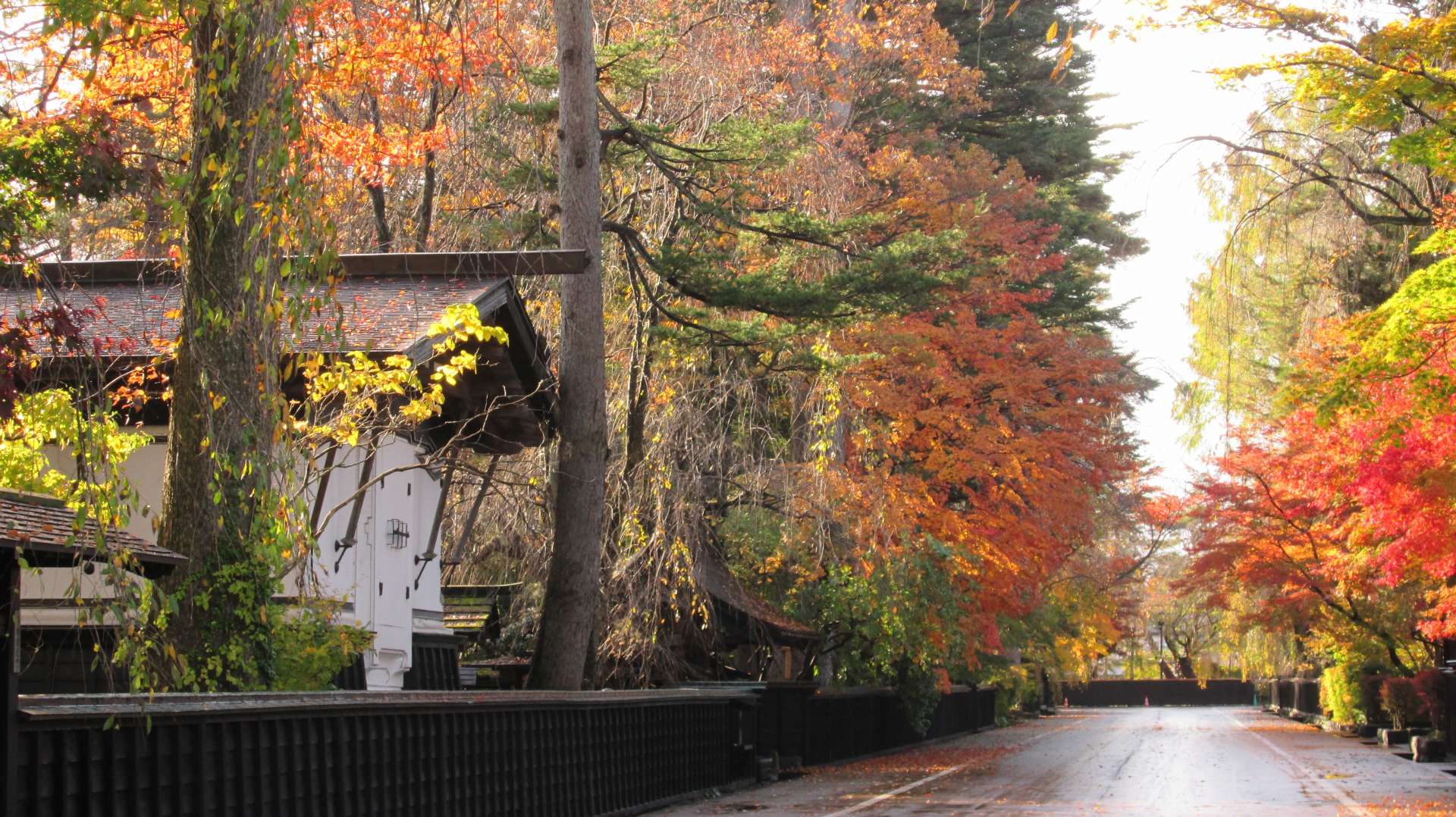
The Aoyagi House covers an area of 3,000 tsubo (about 10,000 square meters). There are about 600 varieties of plants grown in the spacious courtyard, with beautiful scenery all the year round. The whole residence adopts black-painted batten fences (sasarako-bei) and fall leaves stretching out of the wall as if in and greet passers-by.
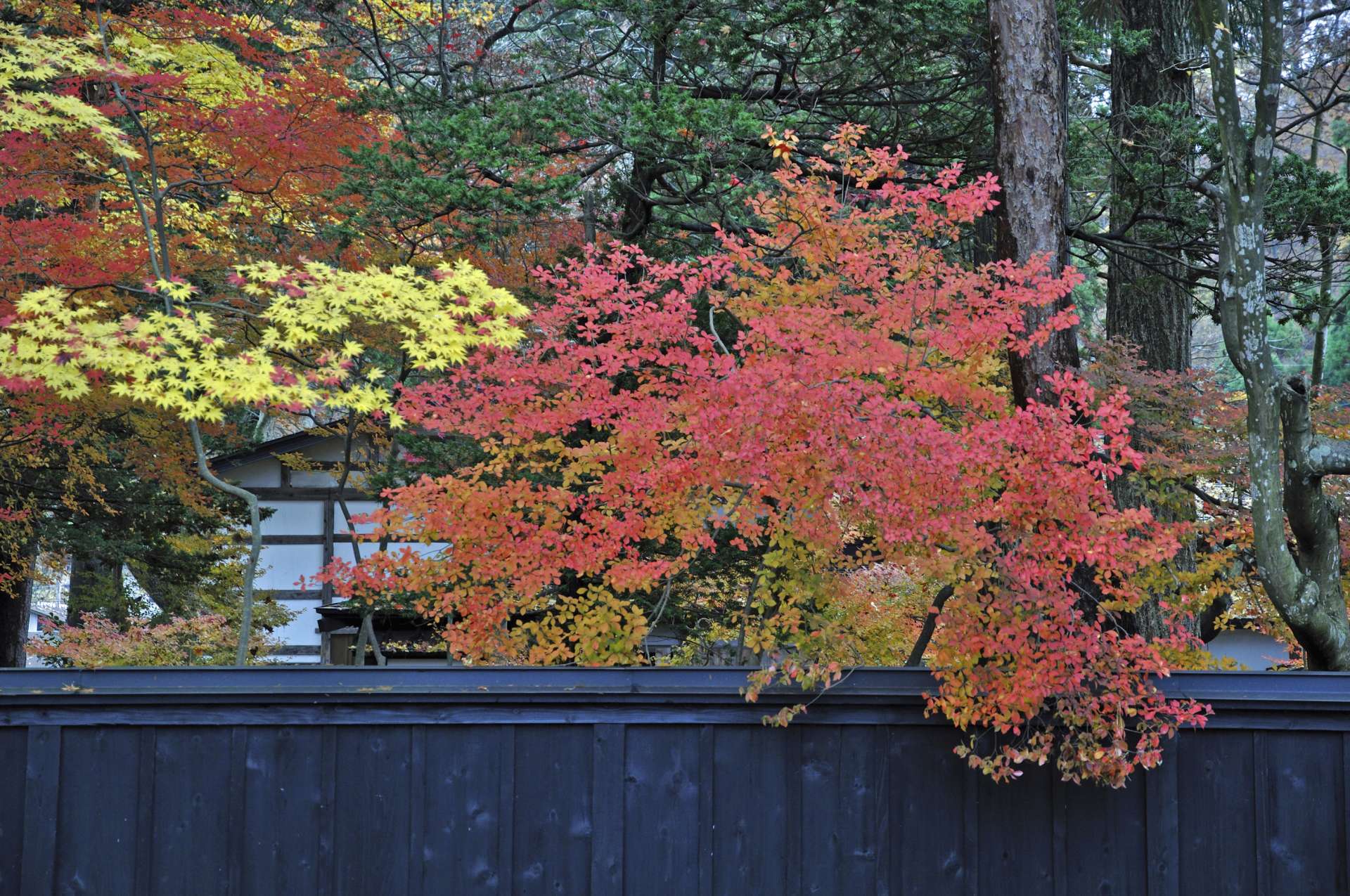
On After entering the broad courtyard from the front door, you will be greeted with Wells, a rice barn, an armory on the north side, and according to the identity of visiting guests and divided into the front door porch and side porch, the main room for the master dedicated bedroom, do not receive guests, the whole residence is very imposing.



Now the residence is established with the Kaitai Shinsho (literally New Text on Anatomy) Memorial Hall, the Akita Folk Museum (Kyoto-kan), the Samurai Tool Museum (Buke Dogu-kan), the Western Style Museum (Yofu-kan), the Museum of the Photos on the Closing Days of the Tokugawa Shogunate Regime (Bakumatsu Photo Museum) and the Period Experience House, and about 30,000 valuable ancient cultural relics are publicly available.
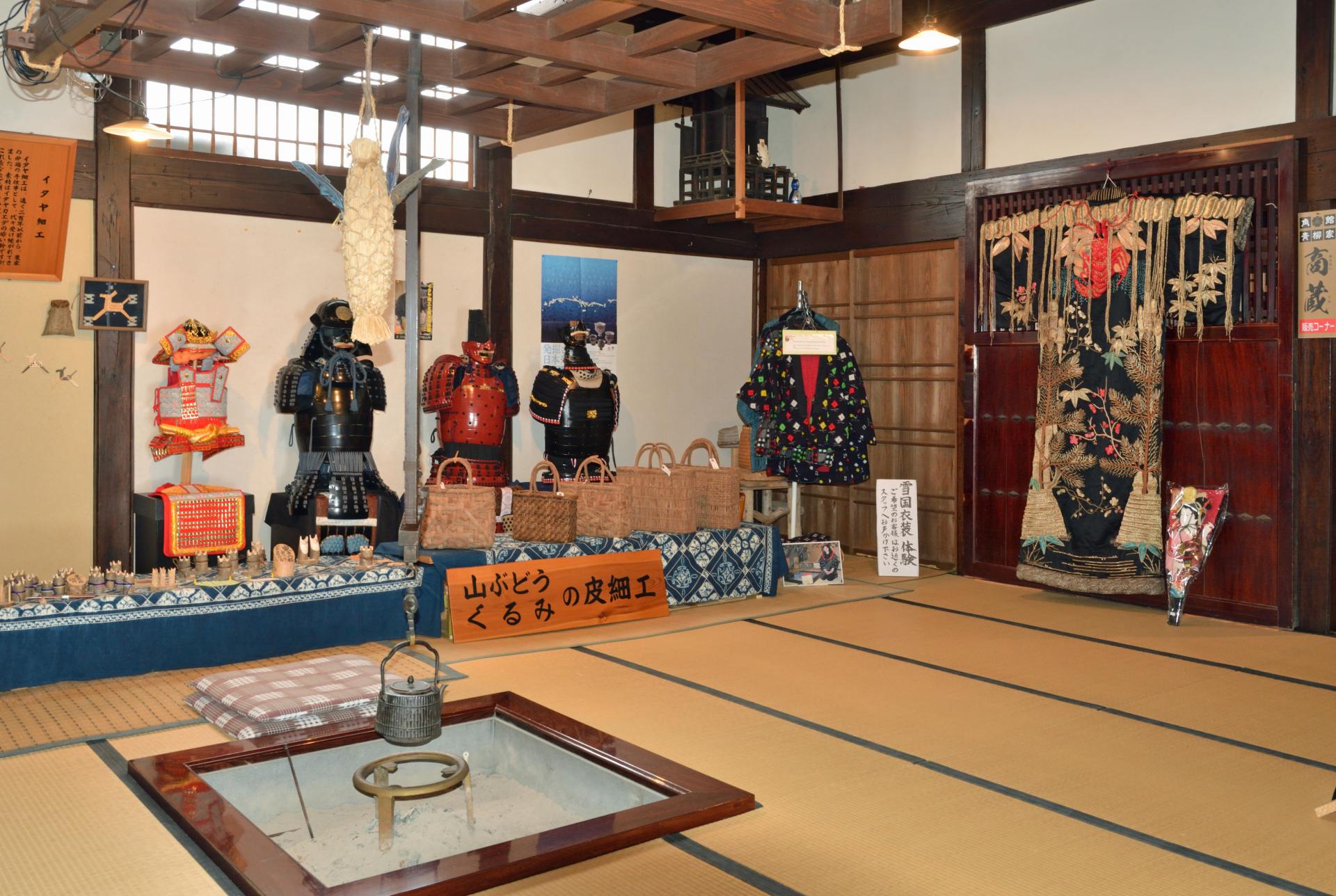
The Aoyagi family was related by marriage to the Odano family mentioned above, so there is a stone statue of Odano Naotake, an artist from the Odano family.

On the first floor of the Western Style Museum, there is a café, which offers “Nanban-cha” (actually coffee) (500 yen) brewed with the sacred water that flowed into the pavilion hundreds of years ago (“Shinmei” water) and various types of dessert; beside the Museum of the Photos on the Closing Days of the Tokugawa Shogunate Regime, there is the Morinoshoku Sai-kan, where you can savor Inaniwa Udon, the traditional food of Akita. It is recommended to have lunch and rest your feet here.

Video on the Fall Foliage around the Aoyagi House
Basic Information on the Aoyagi House
- Address
- 3, Omotemachi-shimo-cho, Kakunodate, Senboku, Akita Prefecture
- Phone
- 0187-43-3257
- Hours
- 9:00-17:00 (9:00-16:30 between December and March)
- Closed
- No
- Admission
- Adults: 500 yen; junior high-school and high-school students, 300 yen; elementary school students: 200 yen
- Official website (traditional Chinese)
- http://www.samuraiworld.com/taiwan/index.html
7. Samurai house: Ishiguro House
Among the existing samurai houses in Kakunodate, the Ishiguro House at the northernmost end of Samurai House Street is most ancient. There are also many fir trees in the gardens, illiard branches, etc., with many trees lasting more than 250 years.
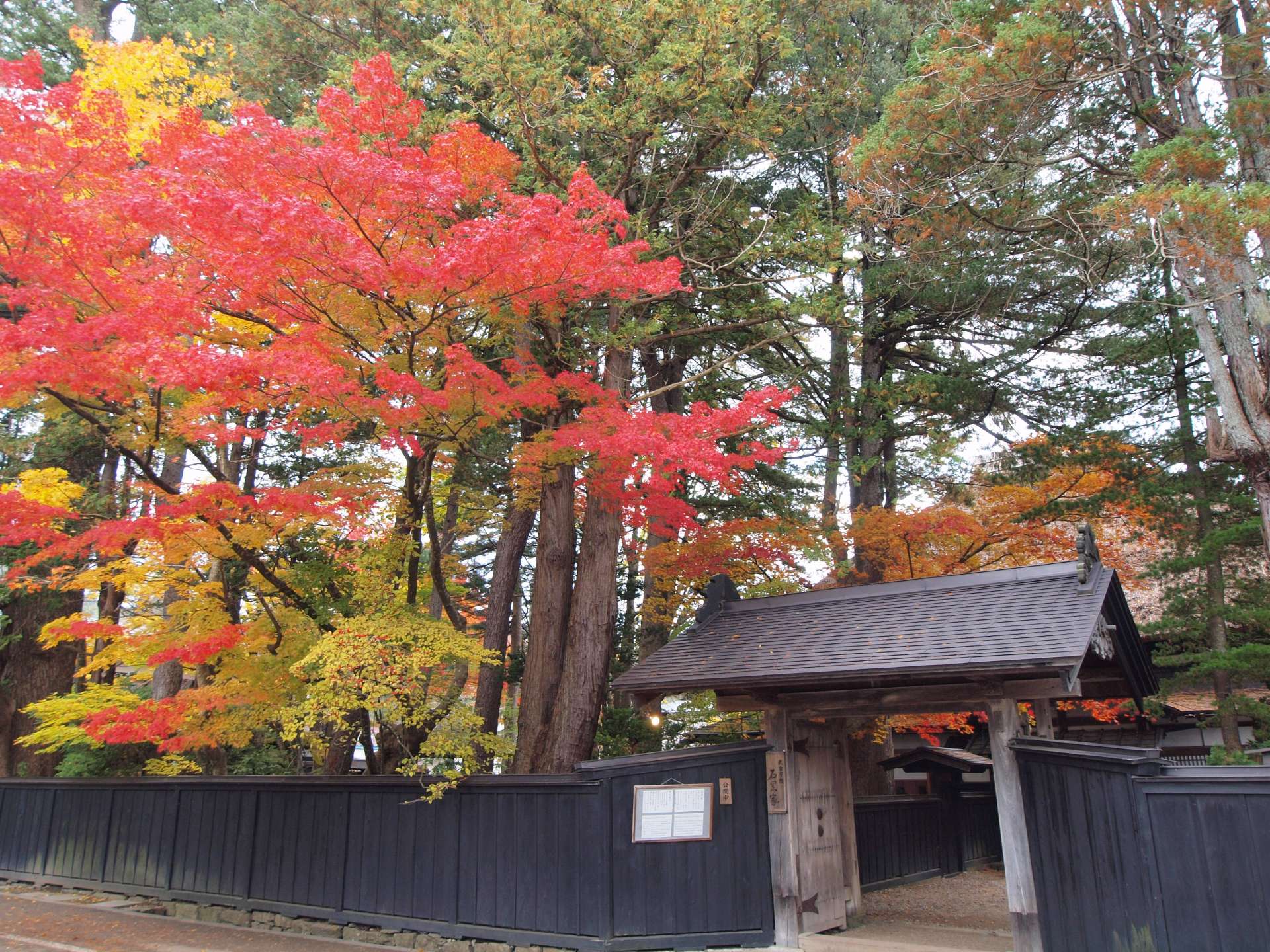
Relative to the luxurious Aoyagi House, the characteristic of Ishiguro House is to have more primitive temperament. With the main building, doors, walls and earthen storehouses representative of the Edo period, the House built in the architectural style of the period between the 18th century and the 19th century is well preserved.
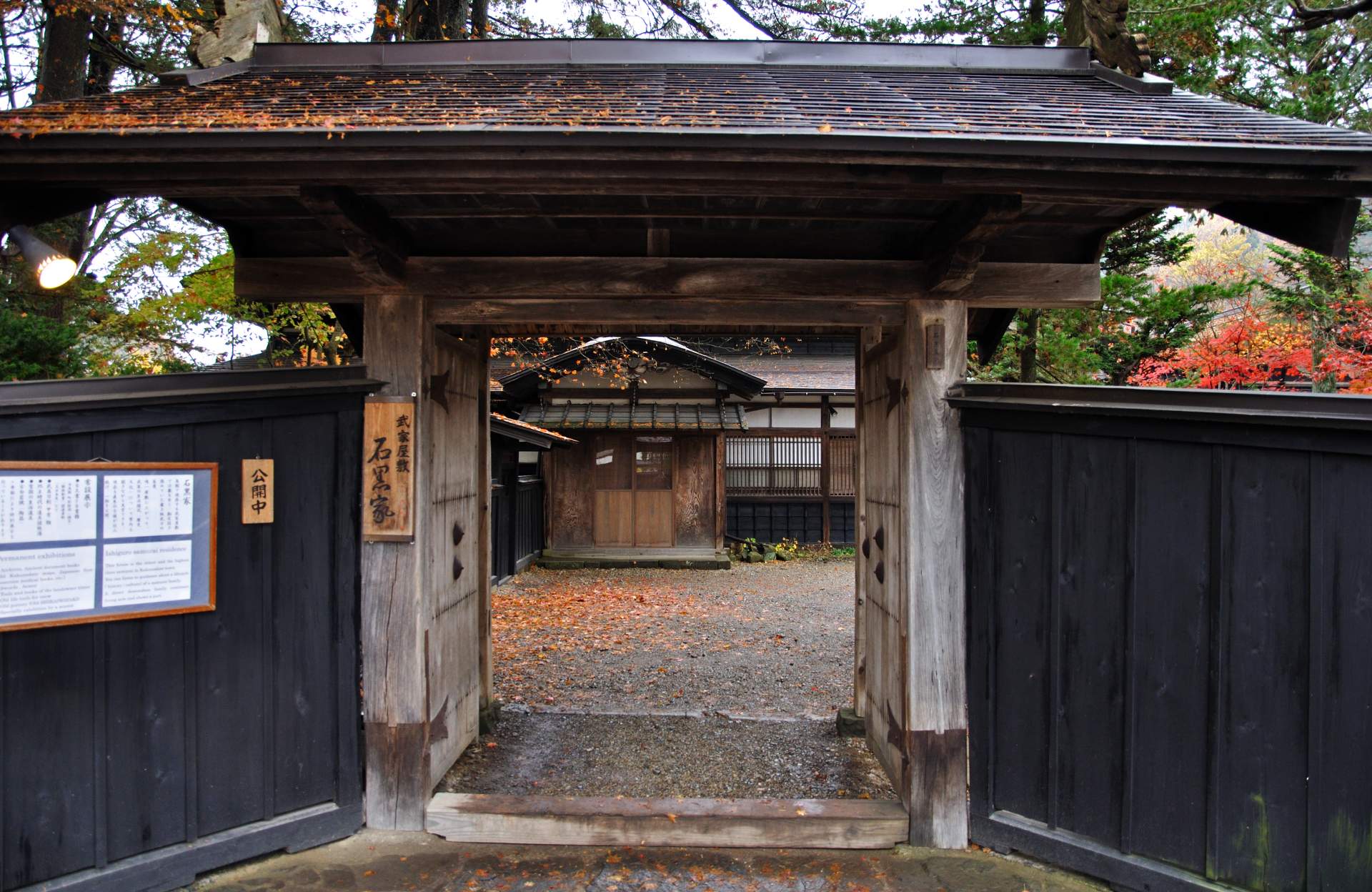
Among the samurai houses in Kakunodate, the Ishiguro House had the most distinguished pedigree. The courtyard now only has ancient trees and ancient buildings, occasionally with moss spreaded on some paved path. The perfect reproduction of the simple and unsophisticated samurai house is inevitably fascinating.

Basic Information on the Ishiguro House
- Address
- 1, Omotemachi-shimo-cho, Kakunodate, Senboku, Akita Prefecture
- Phone
- 0187-55-1496
- Hours
-
9:00-17:00
9:00-17:00 - Admission
- Adults: 300 yen; junior high-school and high-school students, and elementary school students: 150 yen
- Closed
- NO
- Official website (in Japanese)
- http://www.hana.or.jp/~bukeishi/
8. Kakunodate Birch Craft Densho-kan
The Kakunodate Birch Craft Densho-kan was built to exhibit the renowned birch craft of Akita Prefecture. Any festival event held at Kakunodate is surely accompanied with a variety of activities or exhibitions in the museum.
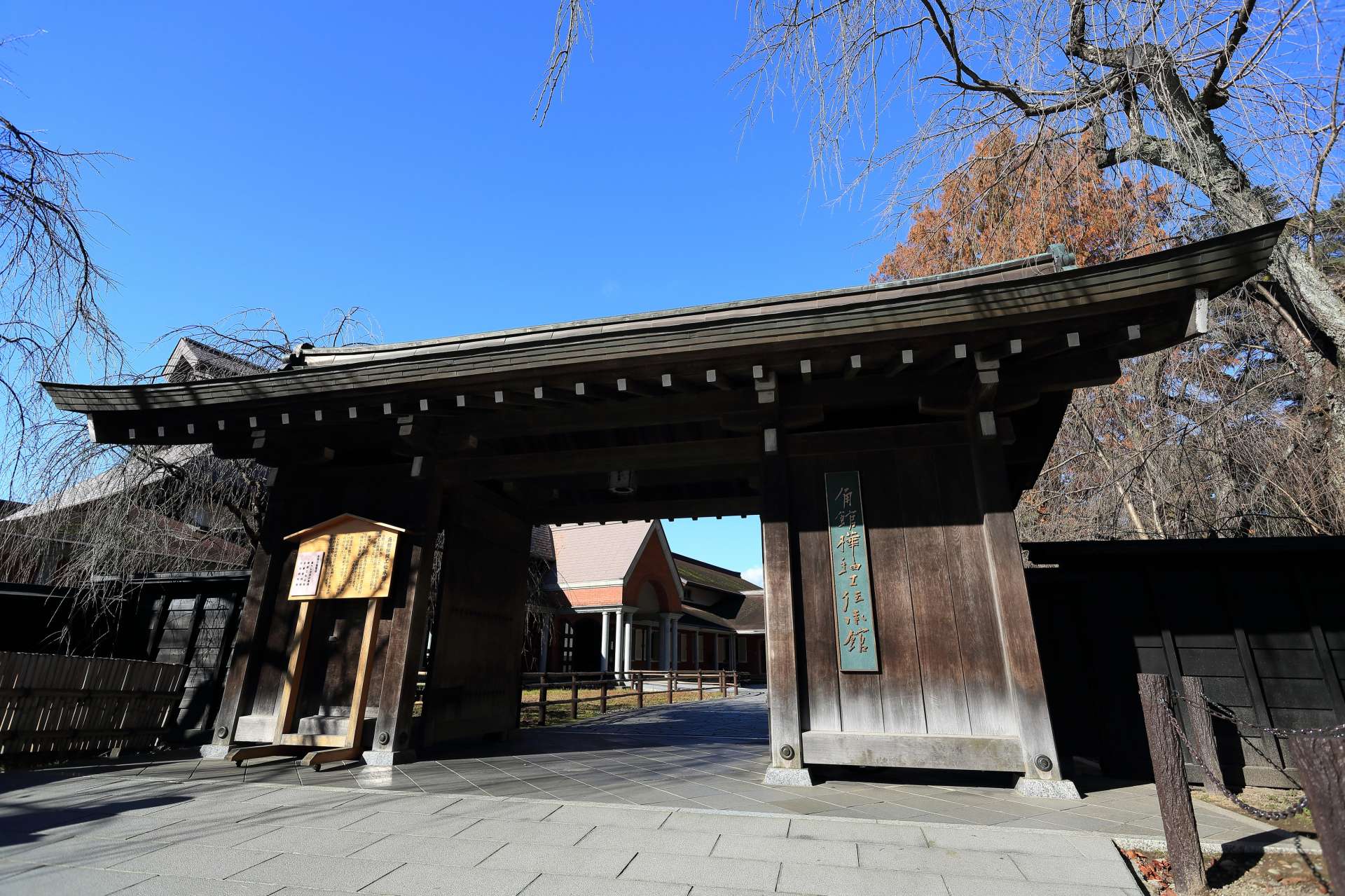
Birch crafts refers to the mountain cherry tree bark paste together, and make such fine objects as tea canisters, stationery and other daily necessities by experienced artisans. There are birch craftsmen demonstrating the skills in the museum, in addition to the experience of making with your own hands!
※ Minimum of 4 people can participate, at 2000 yen per person.

By the way, Kakunodate Birch Craft Densho-kan is also known for sakura viewing. If you visit in the spring, you can enjoy the beauty of the cherry trees on both sides of the gate and the cherry blossoms in the garden.

Basic Information on Kakunodate Birch Craft Densho-kan
- Address
- 10-1, Omotemachi-shimo-cho, Kakunodate, Senboku, Akita Prefecture
- Phone
- 0187-54-1700
- Hours
- 9:00-17:00 (April to November) / 9:00-16:30 (December to March)
- Closed
- December 28 to January 4
- Admission
- High school students and older: 300 yen; middle school and elementary school students: 150 yen; 6 years old and younger: free
9. Samurai House: Matsumoto House
The Matsumoto House differs greatly in architectural style with all the other samurai houses mentioned above. Matsumoto came from a scholar family, at that time belongs to the "lower samurai residence", so slightly humble. Like the Iwahashi House, the Matsumoto House was also a shooting location for the Jidaigeki movie The Twilight Samurai.

Featuring a thatched roof and fenced walls made of cedar bark, it is the only house in Akita that perfectly preserves this architectural style. Therefore, it was recognized as the designated cultural heritage of Akita Prefecture.
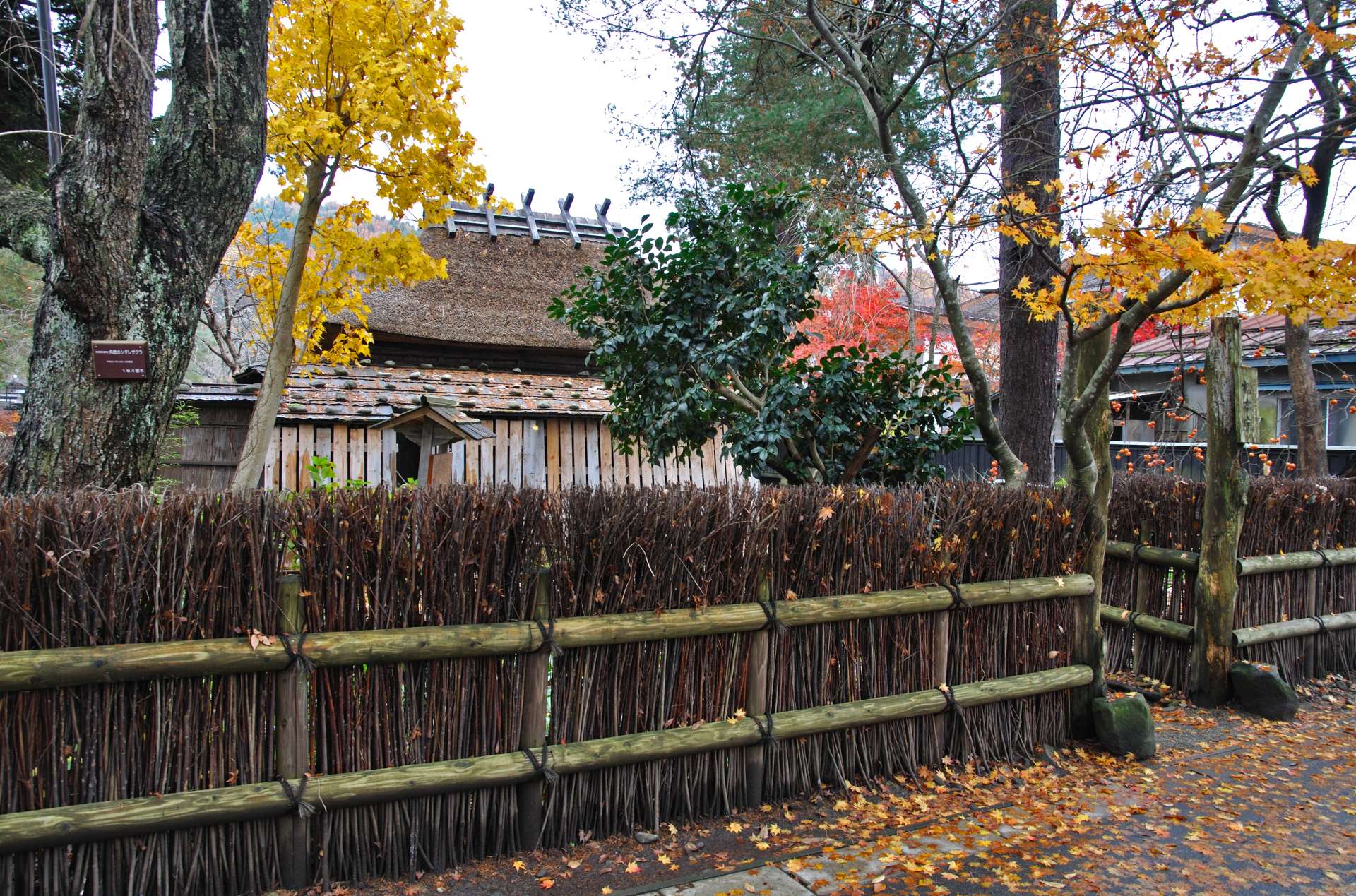
Basic Information on the Matsumoto House
- Address
- 4, Kobitomachi, Kakunodate, Senboku, Akita Prefecture
- Phone
- 0187-43-3384
- Dates
- Mid-April to November
- Hours
- 9:00-16:30
- Closed
- Admission
- Free
10.Samurai House: Nishinomiya House
The Nishinomiya family was the largest family of wealthy merchant and landlord in Kakunodate. From the Meiji period to the Taisho period, a library and a rice barn were built in the broad courtyard, both now together with the main building, have been transformed into a famous scenic spot representing Tamachi Bukeyashiki Street.
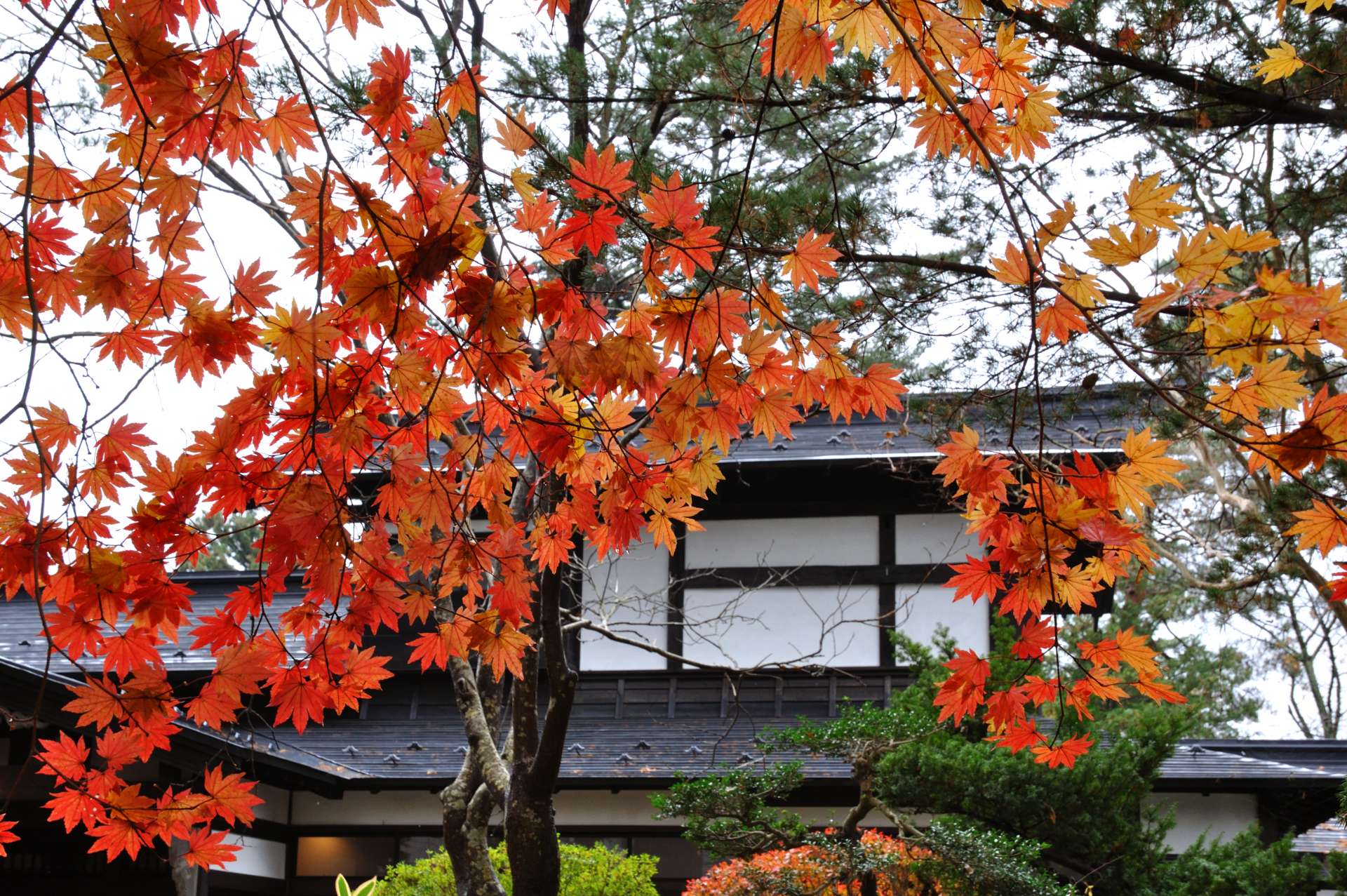
Many historical documents and cultural relics are now on display in the Library; Japanese-style commodities are sold in the rice barn; the front storehouse is transform into a conference room; the northern storehouse is a café; the gakko storehouse sells local tsukemono (literally “pickled things”) and specialties, while the main building is a dining room for tourists and high-grade matcha is also sold there.

Basic Information on the Nishinomiya House
- Address
- 11-1, Tamachi-kamicho, Kakunodate, Senboku, Akita Prefecture
- Phone
- 0187-52-2438
- Hours
- 10:00-17:00
- Closed
- No
- Admission
- Free
11. Shinchosha Memorial Museum of Literature
The Shinchosha Memorial Museum of Literature is a MUST-VISIT photo scenic spot ! The wall is engraved with the opening paragraph of Snow Country (Yukiguni) by Yasunari Kawabata, the first Japanese author to receive the Nobel Prize for Literature.

“The train came out of the long tunnel into the snow country. The earth lay white under the night sky. The train pulled up at a signal stop.” It is a paragraph that almost every Japanese can recite. Readers will feel as if they are also entering into the snow country.
The ones who have read this novel might ask, The stage of "Snow country" is Niigata Prefecture, why it mentioned in this article on Kakunodate? In fact, Shincho Bunko and the author of the Snow Country became known to every family after the publication of the first edition of "Snow country". And Sato Giryo, the founder of Shinchosha, the publisher of Shincho Bunko, came from Kakunodate.
Basic Information on the Shinchosha Memorial Museum of Literature
- Address
- 23, Tamachi-kamicho, Kakunodate, Senboku, Akita Prefecture
- Phone
- 0187-43-3333
- Hours
- 9:00-17:00 (April to November) / 9:00~16:30 (December to March)
- Admission
- High school students and older: 300 yen; middle school and elementary school students: 150 yen; 6 years old and younger: free
- Closed
- Mondays, December 28 to April 4
12. Ando Workshop
Founded in 1853, Audo Workshop is a workshop mainly making miso and soy sauce brewing. This red-brick warehouse adopts a fire protection design.

The store sells heiry-passed miso and soy sauce, as well as a variety of pickles and other local products, and offers free samples of heiry-passed traditional miso of Akita Prefecture.

Basic Information on Ando Workshop
- Address
- 27, Shimo-shinmachi, Kakunodate, Senboku, Akita Prefecture
- Phone
- 0187-53-2008
- Hours
- 8:30-18:00
- Closed
- No
- Admission
- Free
Illumination of Fall Foliage at Night
The best time to see the fall foliage at Kakunodate is generally from late October to mid-November. During this period, Bukeyashiki Street will be lit up between 16:30 and 22:00 every day.
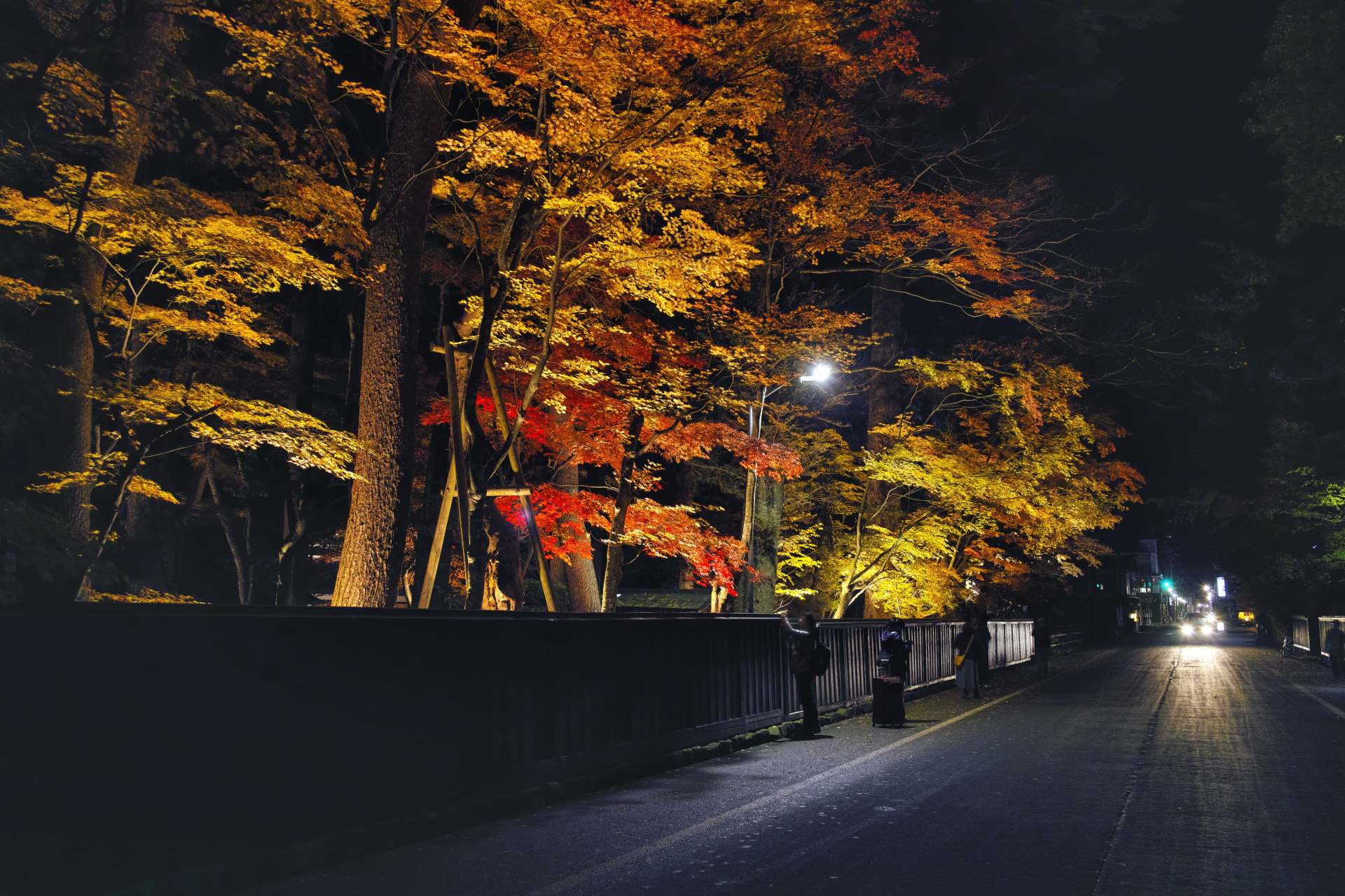
This fall foliage walking route between Odano House through Matsumoto House (no.3 through no.9 mentioned in this article) illuminated at night, makes up a great scene of romance, that can be appreciated everywhere. ♡
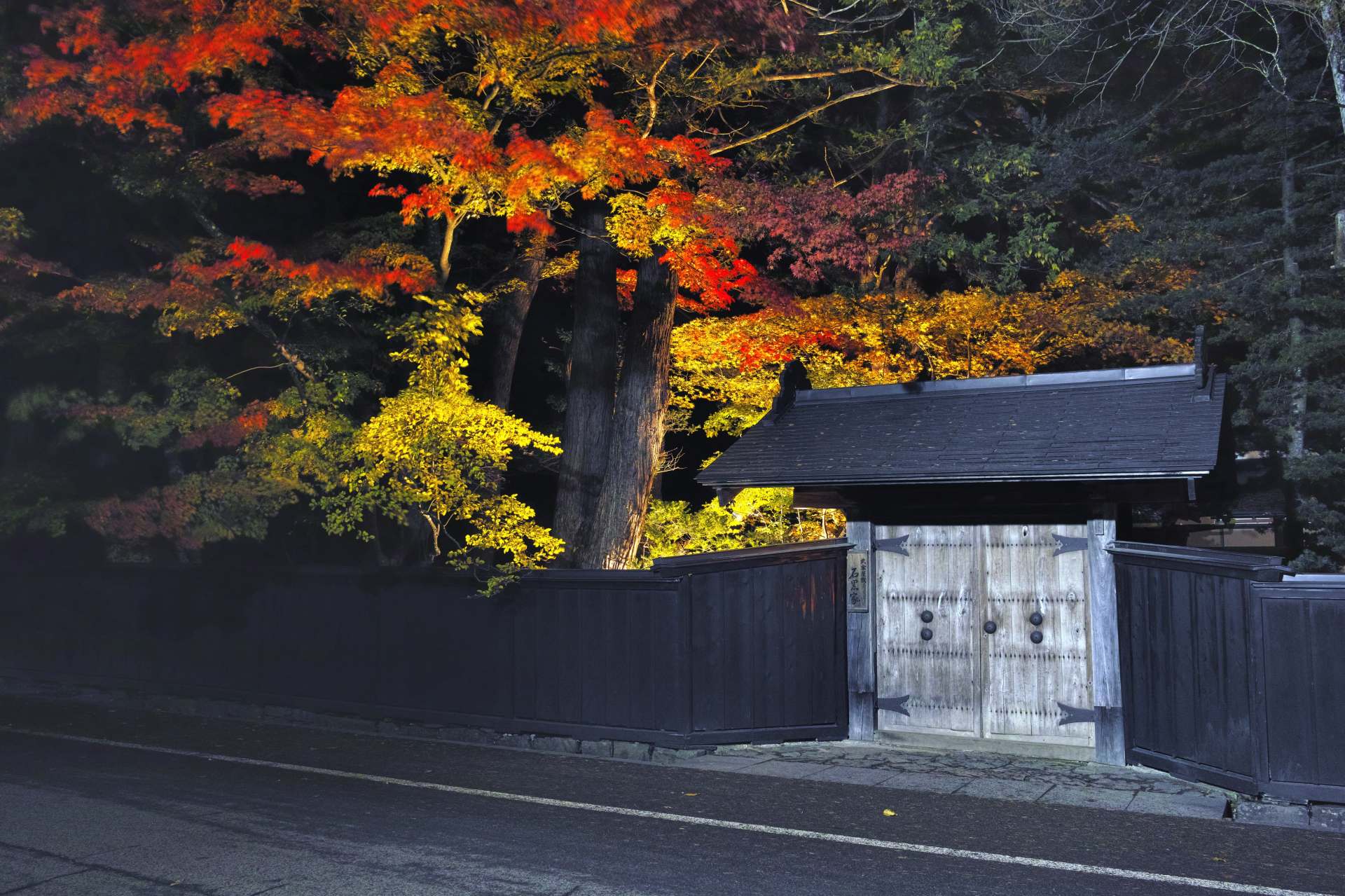
Basic Information on the Illumination of Fall Foliage at Night (2023)
- Dates
- October 13 to November 26, 2023
- Hours
- 16:30-22:00
- Place
- Bukeyashiki Street
- Official website (in Japanese)
- https://tazawako-kakunodate.com/ja/events/203
Fall Foliage Viewing on a Rickshaw
Tired of walking? Hop on a ricksaw! You can take a rickshaw at Kakunodate Birch Craft Densho-kan (no.8); Enjoy your rickshaw trip for 15-minute, 30-minute or even an hour! One rickshaw can take up to 2 persons.
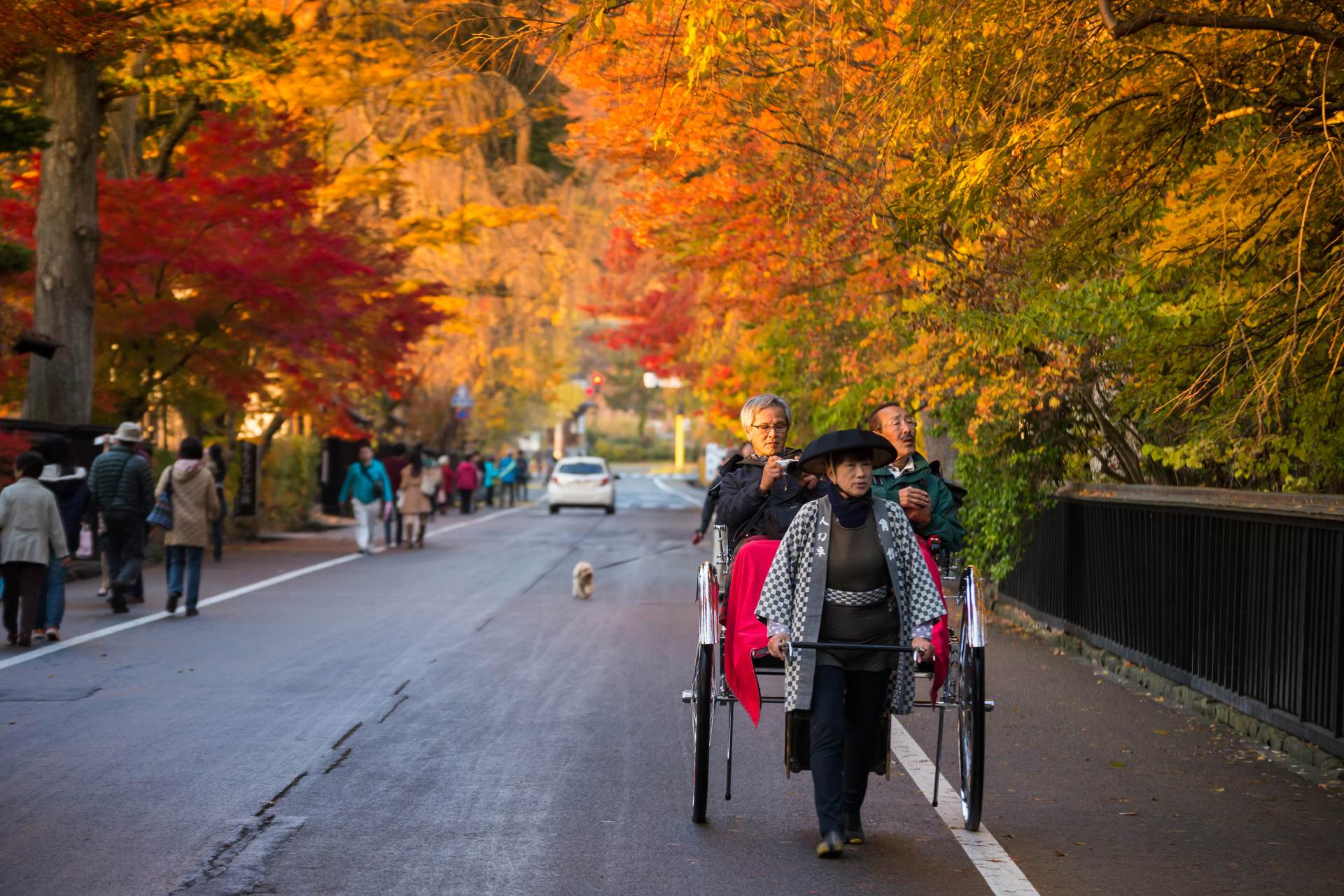
Basic Information on Kakunodate Rickshaw Company
- Phone
- 090-2970-2324
- Hours
- 9:00-17:00
- Place to take a rickshaw
- Opposite to Kakunodate Birch Craft Densho-kan (10-1, Omotemachi-shimo-cho, Kakunodate, Senboku, Akita Prefecture)
- Closed
- No
- Price
- 15-minute: 3,000 yen; 30-minute, 5,000 yen; 60-minute, 9,000 yen
Basic Information on Sakurakazetei
- Phone
- 090-2994-2722
- Hours
- 9:00-16:30
- Place to take a rickshaw
- Opposite to Kakunodate Birch Craft Densho-kan (10-1, Omotemachi-shimo-cho, Kakunodate, Senboku, Akita Prefecture)
- Closed
- December to March
- Price
- 15-minute: 3,000 yen; 30-minute, 5,000 yen; 60-minute, 9,000 yen
